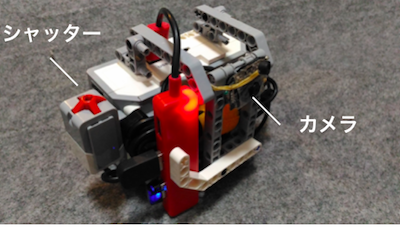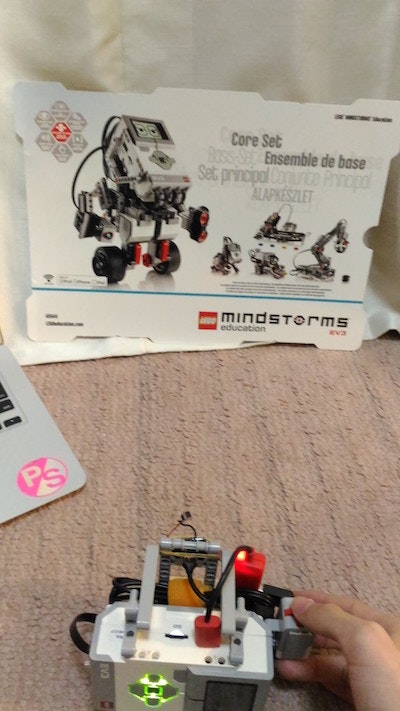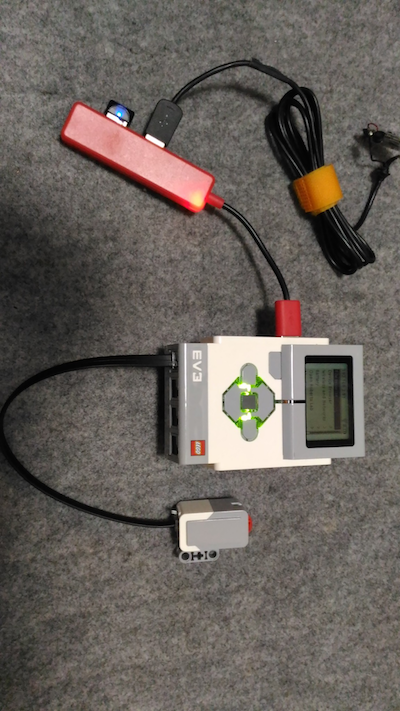はじめに
EV3で動くLinux環境ev3devを使って開発します。この記事は、EV3にev3devをインストールし、SSH接続できている状態であることを前提にしています。
環境構築ができていない方はこちらの記事を参考にしてください。
mindstorm-EV3をLinuxで制御しよう! ev3dev OSのインストールととSSH接続
##必要なもの
- WEBカメラ
Microsoft Corp. LifeCam HD-3000
- USBハブ
##つくるもの
ev3devとWEBカメラを使って簡単なカメラを作ります。
撮影した写真をブラウザから確認、保存できるようにします。
側をしっかり作っていないので分かり辛いですが、シャッター(タッチセンサー)を押すと、カメラが画像を取得して、PCのブラウザに表示するという仕組みです。

シャッターを押すと..

リアルタイムにPCのブラウザに画像が表示されます。

##環境構築
WEBカメラから画像を取得するにはfswebcamというコマンドを利用します。
また、今回利用するプログラムをGitHubからクローンします。
#fswebcamのインストール
robot@ev3dev:~$ sudo apt-get install fswebcam
#プログラムのダウンロード
robot@ev3dev:~$ git clone https://github.com/muro-tani/ev3Cam.git
robot@ev3dev:~$ cd ev3Cam
robot@ev3dev:~/ev3Cam$ npm install
##実行
EV3インテリジェントブロックにUSBハブを接続し、そこにUSBドングルとWEBカメラを接続します。
次に、EV3インテリジェントブロックの1番ポートにタッチセンサーを接続します。

その後、プログラムを起動させます。
robot@ev3dev:~/ev3Cam$ node index.js
http://ev3dev.local:1337にアクセスすれば完了です。
タッチセンサーを押して離すと、カメラが取得した画像がブラウザをに表示されます。
##WEBカメラの認識
lsusbコマンドで確認します。
robot@ev3dev:~$ lsusb
Bus 001 Device 004: ID 045e:0779 Microsoft Corp. LifeCam HD-3000
Bus 001 Device 003: ID 0411:01ee BUFFALO INC. (formerly MelCo., Inc.) WLI-UC-GNM2 Wireless LAN Adapter [Ralink RT3070]
Bus 001 Device 002: ID 1a40:0101 Terminus Technology Inc. 4-Port HUB
Bus 001 Device 001: ID 1d6b:0001 Linux Foundation 1.1 root hub
##WEBカメラから画像を取得
fswebcamコマンドを実行してみましょう。第一引数に保存先のファイル名を指定します。
robot@ev3dev:~$ fswebcam test.jpg
--- Opening /dev/video0...
Trying source module v4l2...
/dev/video0 opened.
No input was specified, using the first.
Adjusting resolution from 384x288 to 352x288.
--- Capturing frame...
Captured frame in 0.00 seconds.
--- Processing captured image...
Writing JPEG image to 'test.jpg'.
詳しいオプションはこちらの通りです。
robot@ev3dev:~$ fswebcam -h
Usage: fswebcam [<options>] <filename> [[<options>] <filename> ... ]
Options:
-?, --help Display this help page and exit.
-c, --config <filename> Load configuration from file.
-q, --quiet Hides all messages except for errors.
-v, --verbose Displays extra messages while capturing
--version Displays the version and exits.
-l, --loop <seconds> Run in loop mode.
-b, --background Run in the background.
-o, --output <filename> Output the log to a file.
-d, --device <name> Sets the source to use.
-i, --input <number/name> Selects the input to use.
-t, --tuner <number> Selects the tuner to use.
-f, --frequency <number> Selects the frequency use.
-p, --palette <name> Selects the palette format to use.
-D, --delay <number> Sets the pre-capture delay time. (seconds)
-r, --resolution <size> Sets the capture resolution.
--fps <framerate> Sets the capture frame rate.
-F, --frames <number> Sets the number of frames to capture.
-S, --skip <number> Sets the number of frames to skip.
--dumpframe <filename> Dump a raw frame to file.
-s, --set <name>=<value> Sets a control value.
--revert Restores original captured image.
--flip <direction> Flips the image. (h, v)
--crop <size>[,<offset>] Crop a part of the image.
--scale <size> Scales the image.
--rotate <angle> Rotates the image in right angles.
--deinterlace Reduces interlace artifacts.
--invert Inverts the images colours.
--greyscale Removes colour from the image.
--swapchannels <c1c2> Swap channels c1 and c2.
--no-banner Hides the banner.
--top-banner Puts the banner at the top.
--bottom-banner Puts the banner at the bottom. (Default)
--banner-colour <colour> Sets the banner colour. (#AARRGGBB)
--line-colour <colour> Sets the banner line colour.
--text-colour <colour> Sets the text colour.
--font <[name][:size]> Sets the font and/or size.
--no-shadow Disables the text shadow.
--shadow Enables the text shadow.
--title <text> Sets the main title. (top left)
--no-title Clears the main title.
--subtitle <text> Sets the sub-title. (bottom left)
--no-subtitle Clears the sub-title.
--timestamp <format> Sets the timestamp format. (top right)
--no-timestamp Clears the timestamp.
--gmt Use GMT instead of local timezone.
--info <text> Sets the info text. (bottom right)
--no-info Clears the info text.
--underlay <PNG image> Sets the underlay image.
--no-underlay Clears the underlay.
--overlay <PNG image> Sets the overlay image.
--no-overlay Clears the overlay.
--jpeg <factor> Outputs a JPEG image. (-1, 0 - 95)
--png <factor> Outputs a PNG image. (-1, 0 - 10)
--save <filename> Save image to file.
--exec <command> Execute a command and wait for it to complete.
##後編